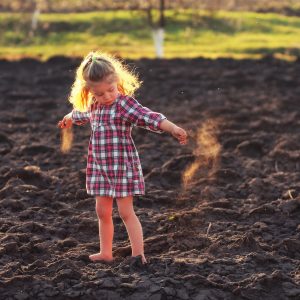
All mammal babies learn through play, from kittens pouncing on balls of wool to puppies who play-fight. Generally, the more intelligent the species is, the longer the ‘childhood’ and the more playing they do.
It should come as no surprise then to recognise that humans are perhaps without equal in both our love of play and the length of our childhoods. Every culture and tribe that has been studied confirms that their children play (even if they also work); it is one of the few universals of childhood.
Playing is a serious business for toddlers and is how they best learn. So rather than worrying about flashcards, letters and numbers, encourage your toddler to play and play.

Maria Montessori (1870-1915) is one of the most influential early years educators. Her theory states that children use all their senses to learn and they are naturally drawn to the right learning experiences for them. Children are also driven by the process of playing, not the end result.
Since the manufacture of mass-produced toys and an increasing insistence on cleanliness and 100% safety, some children miss out on really wonderful sensory play. Even as an adult, it can be lovely to walk through mud in bare feet or stroke a velvet cushion. When you think about sensory play it’s as simple as thinking about the different senses and how they can be activated:
Below are lots of ideas to help your toddler learn through their senses. Some of them you can plan for and some of them you should just take advantage of when the moment arises.

Open a package full of bubble wrap, shredded paper, maize packaging beads and let your child dive in (in the autumn, just use a pile of autumn leaves!) Your toddler will have more fun from squashing the bubble wrap and loose packaging with her fingers, hands and stomping feet than anything that was wrapped inside…put it all in an empty bath, put the plug in and let her sit and explore or stomp up and down feeling everything squash or pop under her toes. Don’t deny yourself either…what other companion in daily life would let you spend 20 minutes popping bubble wrap?

I would always recommend having spare clothes and some spare time built into your schedule to let your toddler take advantage of water play. The feeling of the wet grass under your toddler’s toes and the shock when the sprinkler moves and she is suddenly ‘hit’ with a wall of rain is invaluable and priceless. Your toddler will also then love to anticipate the sensation and repeat it over and over again.
So try not to save water play for the water park as toddlers love to live in the moment and take advantage of something exciting. Try not to restrict play to play areas and playtime.
The same goes for if you come across a massive puddle. If I was close to home I would always let my toddler have an unscheduled paddle.

Mud is another joyful experience but you do need to be careful – it’s possible to get into difficulty if you go mud-walking around estuaries. If it’s safe, walking barefoot in mud is so good as to be therapeutic. Let your toddler walk through mud and enjoy the sensation of soft mud oozing through her toes when the opportunity arises.

A lot of your toddler’s early experimenting with food and solids is a form of sensory play. They are happy to multitask when they eat – and who can blame them? I remember loving to sculpt my mashed potato as much as I enjoyed eating it.
Noodles and cooked spaghetti are wonderful to touch and hold. If you want to make it more of a play experience than an eating experience you can also dye spaghetti or noodles into several different colours with food colouring. The texture of the noodles is lovely to squish and the dexterity required to pick out one noodle is great for those opposable thumb fine motor skills. The different colours are also a feast for the eyes and it’s fun to mix up the colours and fun to separate out the colours.

Whether it’s bath time, washing up or just five minutes with a big bowl of water, toddlers have a natural affinity with water. It’s great sensory play and also a great opportunity to learn about the natural laws of physics with the behaviour of liquids (occupying their containers and be pourable from one container to another). You can give your child a variety of objects and let them see which float and which sink. Try to include some natural objects like sticks, corks, lentils, seeds and stones to test too. A little tea set or a waterwheel are great toys to use in water too, whether outside, in the bath or in the washing up bowl.

It’s possible to play with a variety of substances that offer intriguing textures, including:
Seeing your toddler hosting a pretend tea party with you and her teddy bears is a really lovely milestone in your toddler’s development. Pretend play is where a child will use representative items to play and enact real interactions, so if your toddler holds a brick to her ear and pretends to talk on the phone, this is a real cognitive leap.
The next leap in play is when your toddler is able to play with another child and share pretend play. This generally requires more language, which is one of the reasons it comes later. In pretend play two children are improvising and they need to explain what their props are and what they are doing. Obviously, this becomes much easier when a child can hold up a banana and say ‘ring ring’ and ‘mummy on phone’. Adults will fill in the blanks and suggest story lines but toddlers find this hard to do, so initial shared play is basic in terms of plot but rich in connection. That said, toddlers together will mostly engage in parallel play, where they play alongside rather than with each other.
Play in all its forms is how your toddler begins to make sense of the world. During play, your toddler will be effortlessly testing her hypotheses about the world and the objects within her environment. So while it may look disorganised and simple, play is the way your toddler systematically learns how the world works.